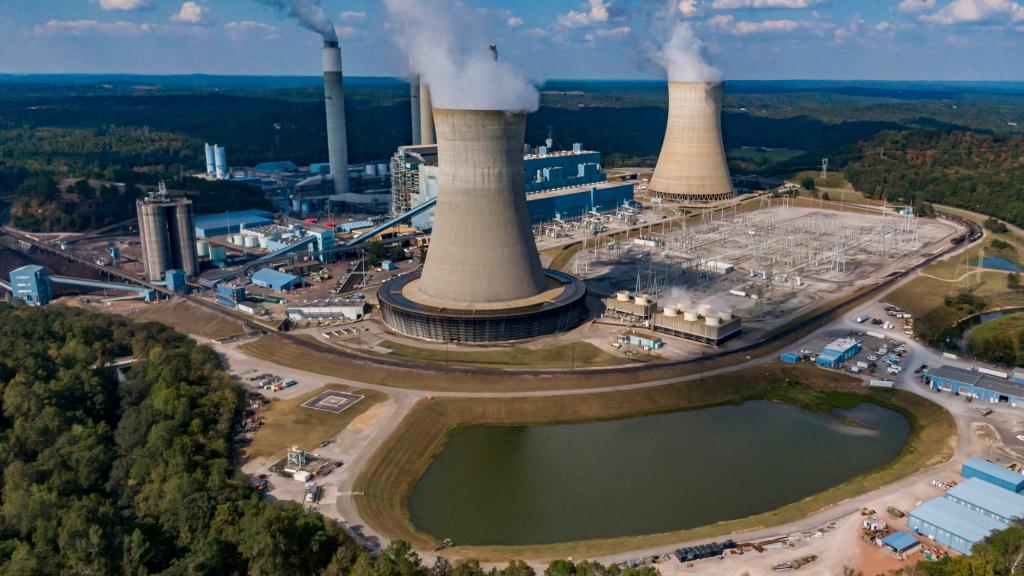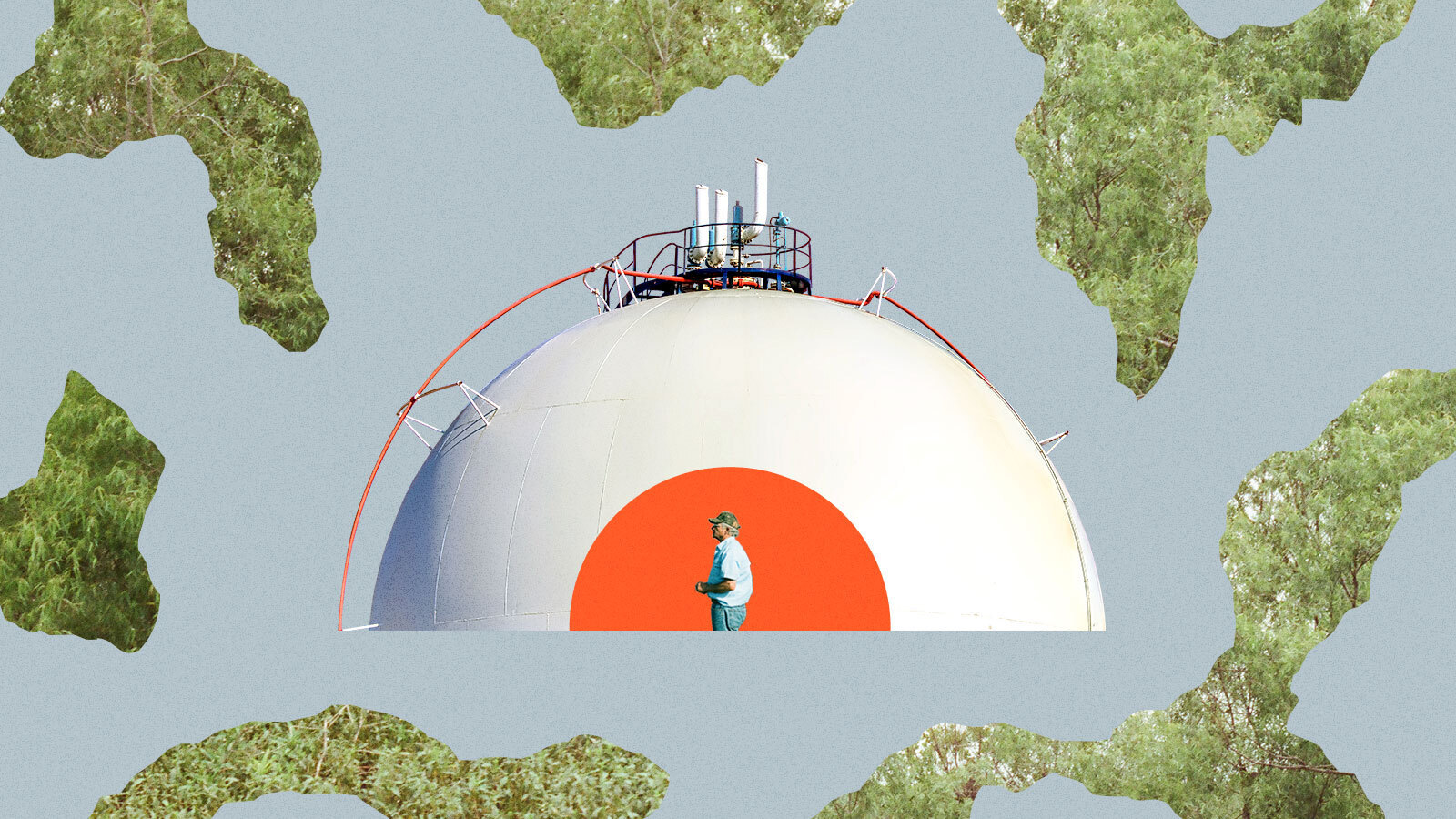Over the past decade, the United States has become the world’s largest exporter of liquefied natural gas, or LNG. Since the fracking boom, gas companies have erected seven massive export terminals along the Gulf Coast, allowing them to sell fracked natural gas overseas for the first time. These terminals compress natural gas into a dense liquid so it can be loaded onto tanker ships and moved around the world like oil.
The industry is poised for more massive growth: There are several other export projects awaiting approval from the Biden administration’s Department of Energy, and more in the pipeline beyond that. If approved, these facilities could almost double the nation’s export capacity by the end of the decade. The question of whether or not to approve this surge in exports has become one of the biggest climate issues President Biden faces as he begins his reelection campaign.
The administration appeared to move toward answering that question this week. The Department of Energy announced on Friday that it would pause approvals for new LNG exports for several months while it reviews how it regulates them. The administration will develop a new approach over the coming year that will foreground the potential climate impacts of exporting natural gas, suspending approvals in the meantime. The decision doesn’t affect active export terminals.
“During this period, we will take a hard look at the impacts of LNG exports,” said President Joe Biden in a statement about the measure. “This pause on new LNG approvals sees the climate crisis for what it is: the existential threat of our time.” In a press call with reporters, senior administration officials noted that U.S. LNG export capacity has more than tripled since the Department of Energy first developed standards for deciding whether to ship gas overseas.
Environmental activists greeted the news of a pause as a victory for nearby residents and the climate. Roishetta Ozane, an activist in Louisiana who has organized to try to stop LNG terminals, said the news “shows that the government recognizes the need to protect the rights and well-being of [Gulf] communities.” Bill McKibben, the longtime climate activist who founded 350.org, said the decision meant Biden had “done more to check dirty energy … than any of his predecessors.”
But the ultimate outcome of the Biden administration’s pause on export approvals is far from certain. Gauging the public interest of new LNG exports is easier said than done, especially when it comes to how those exports affect the trajectory of global warming.
On the one hand, of course, natural gas is a fossil fuel, and burning it releases carbon dioxide. There’s no question that its use contributes to climate change — and that the raw emissions from U.S. LNG would be very large. Venture Global’s CP2 project in Cameron Parish, Louisiana, one of the largest proposed LNG terminals, could move enough gas to produce around 5.7 billion tons of carbon dioxide over its 30-year lifespan. That’s more than 20 times as much carbon as Alaska’s controversial Willow oil project, which Biden approved last year, according to an analysis by the Sierra Club.
However, each country that buys American LNG will be buying it to replace existing sources of energy. If the administration stops permitting new exports, the energy demand in Europe and Asia won’t go away — those countries will just use other sources to meet it. The ultimate impact of exporting gas on the world’s carbon budget — the fast-diminishing amount of carbon dioxide that can still be emitted if global warming is to be limited to internationally-agreed levels — depends on how exactly that substitution plays out. If, for example, the gas mostly replaces more carbon-intensive energy sources like coal, it might actually stretch that carbon budget further than it otherwise would have lasted.
“The reason these export terminals are interesting is because it’s a way that the U.S. government can maybe have an effect on international emissions,” said Sean Smillie, an energy researcher who studied the global LNG market as part of a doctoral project at Carnegie Mellon University. “But we’re not really sure which direction that would go.”
In the case of Lake Charles LNG, one of the largest terminals awaiting approval from the Department of Energy, the exported gas would have a few different destinations. The company behind the project, Energy Transfer, has signed six long-term contracts to supply gas to various buyers. Four of those contracts would send gas to Asian countries including China, and two of them would sell it to oil traders like Shell, which would flip it to the highest bidder. Venture Global’s CP2 project, meanwhile, has inked three long-term supply contracts in Europe, three in Asia, and three with speculative traders. In order to determine the total climate impacts of exporting LNG, the Biden administration will have to calculate how all these contracts balance against each other. (Neither Venture Global nor Energy Transfer could be immediately reached for comment.)
“The question we’re trying to answer is just completely muddled,” said Arvind Ravikumar, an associate professor at the University of Texas at Austin and a codirector of a research group focusing on energy policy. “The answer is, ‘It depends.’ You have to carefully consider what’s happening in other countries. What are they doing with LNG?”
This looks different in every country. Some buyers like China use LNG to replace coal for heating, which has a beneficial effect on the climate, since coal creates more carbon dioxide than natural gas does to produce the same amount of energy. India uses it as a feedstock for fertilizer production. Other countries like Germany are buying it to replace Russian gas that they stopped buying after Russia invaded Ukraine and to avoid having to restart shuttered coal plants.
“The industry might say that that’s true everywhere,” said Ravikumar. “They’d say anyone who buys U.S. LNG replaces coal or dirtier gas. I don’t think that’s true.”
Ravikumar points out that countries such as South Korea and Japan buy LNG to generate electricity, which they could also theoretically get from carbon-free sources if they invested in solar or wind farms, or even built nuclear power plants. In those cases, there’s a solid argument that LNG exports slow down the energy transition.
Nowhere is this dilemma more vexing than in Europe. The continent has been the leading purchaser of LNG from the United States over the past two years, as countries such as Germany race to replace lost Russian gas. This export surge has helped the continent break its previous energy dependence and disentangle itself from Vladimir Putin’s regime. For this reason, gas industry groups in the U.S. say LNG exports are critical for ensuring global energy security.
“U.S. LNG provides energy security to our allies in Europe and around the globe and has helped minimize the largest European energy crisis in recent history,” said Charlie Riedl, the head of the Center for LNG, a liquefied gas trade association, in a November press release. “Limiting U.S. LNG exports will only cause higher energy costs at home and in Europe.” The statement came as Democrats in Congress pressured the Biden administration to reject new export applications.

But some experts say that Europe doesn’t need any more gas from the United States. The continent’s political leadership recently poured billions of dollars into heat pumps and renewable energy — mitigating the need for natural gas for both home heating and electricity. As a result, most analysts expect that European gas demand will fall over the coming years. By the time new gas shipments start flowing from proposed export terminals in 2026 or 2027, Germany might not even need them. Indeed, some argue the widespread availability of new cheap gas might encourage increased energy consumption, adding more emissions to the global carbon ledger.
“There is no reason to believe that Europe’s energy security depends on further expansion of LNG export capacity that would only come online towards the end of this decade,” said Felix Heilmann, a policy analyst at the German think tank Dezernat Zukunft who has studied the LNG industry.
This matches projections from the International Energy Agency, or IEA, a global energy research institution. The IEA said in its annual energy outlook last year that it expects global gas demand to peak by 2030, meaning “there is little headroom remaining for either pipeline or LNG trade to grow beyond then.”
The question of timing is critical, since the climate impacts of new export terminals will extend far beyond the end of the decade. These terminals cost billions of dollars to build, and companies need to operate them for decades in order to reap back their initial investments. The same goes for the import terminals that countries such as South Korea and Pakistan are building to take American gas. Environmental groups argue that building more LNG infrastructure now will “lock in” a dependence on gas in many countries, forcing them to keep burning fossil fuels even as renewables expand. In the call with reporters, a senior Biden administration official said the potential for this dependence was one of the administration’s concerns in the pause.
This might not be as much of a concern in Europe, since countries like Germany have invested in cheaper and more flexible floating import terminals that don’t need to operate for decades. In other parts of the world, though, there is a risk that LNG might slow down the adoption of solar in countries like Pakistan.
“If you build an LNG terminal today, it’s not like it’s going to operate for five years and then shut down,” said Ravikumar. “Between now and 2030, at the global level, on average, LNG might reduce global emissions compared to a counterfactual scenario, but 20 years from now, it might not.”
For Smillie, the researcher who studied LNG at Carnegie Mellon, that uncertainty will make the Biden administration’s analysis very difficult. The export question has become a divisive issue in climate politics, but the effects of a U.S. policy in either direction won’t be clear for years — and they depend largely on decisions in other countries besides the United States.
“A huge part of the story is other countries’ climate policies and climate laws,” he said. “At the end of the day, that’s what will determine whether these LNG terminals have a positive or negative effect on the climate. That’s not really something we can predict.”




